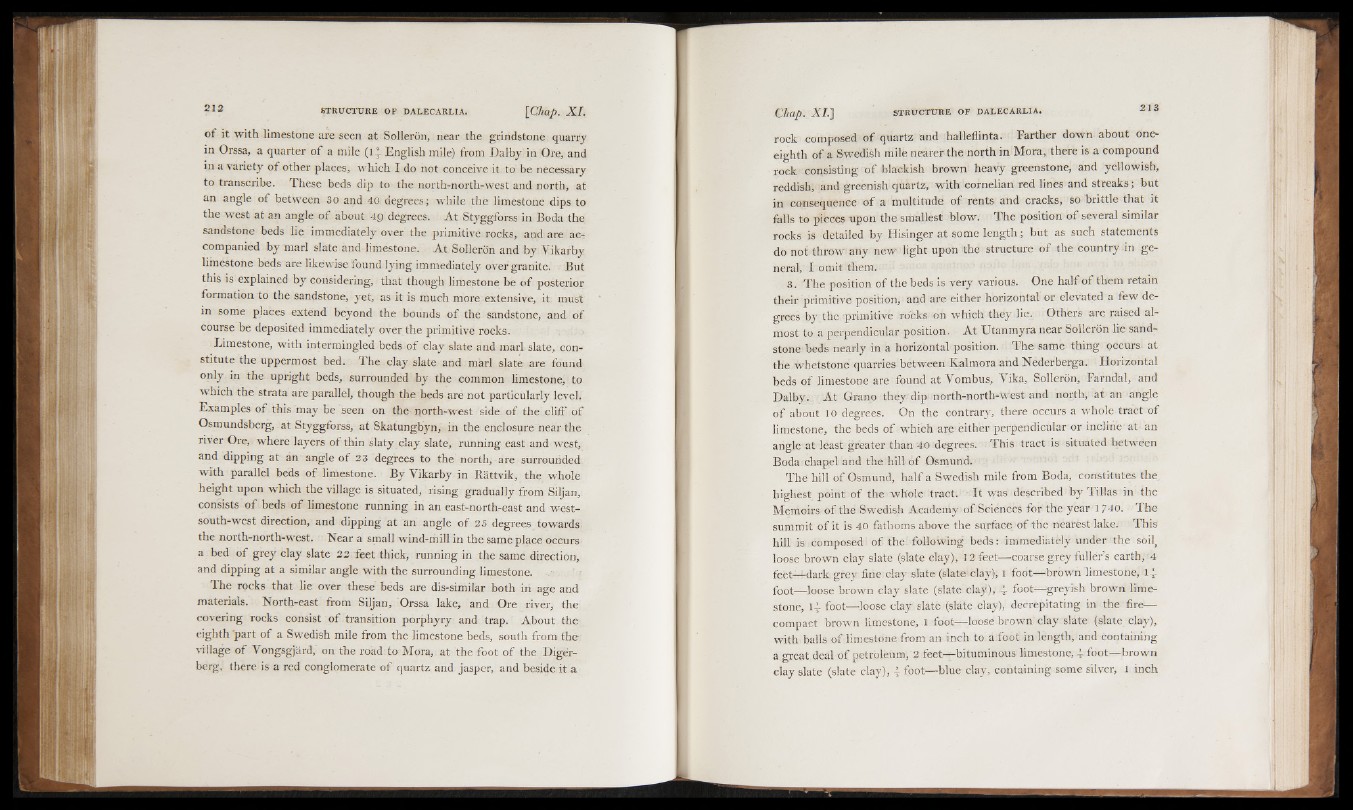
o f it with limestone are seen at Solleron, near the grindstone quarry
in Orssa, a quarter o f a mile (l * English mile) from Dalhy in Ore, and
in a variety o f other places, which I do not conceive it to be necessary
to transcribe. These beds dip to the north-north-west and north, at
an angle o f between 30 and 40 degrees; while the limestone dips to
the west at an angle of about 4g degrees. At Styggforss in Boda the
sandstone beds lie immediately over the primitive rocks, and are ac^
companied by marl slate and limestone. A t Solleron and by Vikarby
limestone beds are likewise found lying immediately over granite. But
this is explained by considering, that though limestone be o f posterior
formation to the sandstone, yet, as it is much more extensive, it must
in some places extend beyond the bounds o f the sandstone, and of
course be deposited immediately over the primitive rocks.
Limestone, with intermingled beds of clay slate and marl slate, constitute
the uppermost bed. The clay slate and marl slate are found
only in the. upright beds, surrounded by the common limestone, to
which the strata are parallel, though the beds are not particularly level.
Examples o f this may be seen on the north-west side of the cliff of
Osmundsberg, at Styggforss, at Skatungbyn, in the enclosure near the
river Ore, where layers of thin slaty clay slate, running east and west,
and dipping at an angle of 23 degrees to the north,-are surrounded
with parallel beds of limestone. By Yikarby in Rattvik, the whole
height upon which the village is situated, rising gradually from Siljan,
consists o f beds o f limestone running in an east-north-east and west-
south-west direction, and dipping at an angle of 25 degrees towards
the north-north-west. Near a small wind-mill in the same place occurs
a bed o f grey clay slate 22: feet thick, running in the same direction,
and dipping at a similar angle with the surrounding limestone.
The rocks that lie over these beds are dis-similar both in age and
materials. North-east from Siljan,. iOrssa lake, and Ore river, the
covering rocks consist of transition porphyry and trap. About the
eighth 'part o f a Swedish mile from the limestone beds, south from the
village o f Vongsgjard, on the road to Mora, at the foot of the Diger-
berg, there is a red conglomerate of quartz and jasper, and beside it a
rock composed of quartz and halleflinta. Farther down about one-
eighth of a Swedish mile nearer the north in Mora, there is a compound
rock consisting of blackish brown heavy greenstone, and yellowish,
reddish, and greenish quartz, with cornelian red lines and streaks; but
in consequence of a multitude of rents and cracks, so brittle that it
falls to pieces upon the smallest blow. The position o f several similar
rocks is detailed by Hisinger at some length; but as such statements
do not throw any new light upon the structure o f the country .in general,
I omit them.
3. The position of the beds is very various. One half o f them retain
their primitive position, and are either horizontal or elevated a few degrees
by the primitive rocks on which they lie. Others are raised almost
to a perpendicular position. At Utanmyra near Solleron lie sandstone
beds nearly in a horizontal position. The same thing occurs- at
the whetstone quarries between Kalmora and Nederberga. Horizontal
beds of limestone are found at Yombus, Yika, Solleron, Farndal, and
Dalby. A t Grano they dip north-north-west and north, at an angle
of about 10 degrees. On the contrary, there occurs a whole tract of
limestone, the beds of which areeitber perpendicular or incline at- an
angle at least greater than 40 degrees. This tract is situated between
Boda chapel and the hill of Osmund.
The hill of Osmund, half a Swedish mile from Boda, constitutes the
highest point of the whole tract. It was described b y Tillas in the
Memoirs of the Swedish Academy >of Sciences for the year 1740. The
summit of it is 40 fathoms above the surface of the nearestlakei This
hill as composed of the: following beds ^immediately under the soil,
loose brown clay slate (slate clay), 12 feet— coarse grey fuller’s earth, 4
feet-4-dark, grey fine clay slate (Slate clay); 1 foot— brown limestone, I f
foot— loose brown clay slate (slate clay).if- foot— greyish brown limestone,
I f foot— loose clay’ slate (slate clayjf decrepitating in the fire—
compact brown limestone, ,1 foot— loose brown clay slate (slate clay),
with balls of limestone from an inch to afoot in length, and containing
a great deal of petroleum, 2 feet——bituminous limestone, , foot brown
clay slate (slate clay), f foot— blue clay, containing some silver, l inch